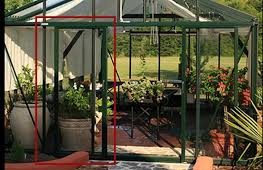A sliding-door greenhouse can be a great addition to any garden, providing a protected environment for plants and vegetables to grow year-round. However, installing a sliding-door greenhouse can be a challenging task, requiring careful planning and execution to ensure a successful and functional result. Here are 10 guidelines to follow when installing a sliding-door greenhouse:
Choose the Right Location
The location of your sliding door greenhouse is critical for its success. You’ll want to choose a spot that receives plenty of sunlight throughout the day and is protected from strong winds and other weather hazards. In addition, you’ll need to consider factors such as soil drainage and access to water and electricity.
Select the Right Size
The size of your sliding door greenhouse will depend on the amount of space you have available and your gardening needs. Consider factors such as the number and type of plants you’ll be growing and the amount of storage space you’ll need for tools and equipment.
Plan the Foundation
A solid and level foundation is essential for a functional sliding-door greenhouse. You’ll need to carefully plan and prepare the foundation, taking into account factors such as the type of soil, the climate, and the weight of the greenhouse itself.
Choose the Right Materials
When it comes to materials for your sliding doors greenhouse, there are a variety of options to choose from. You’ll want to select materials that are durable and able to withstand the elements, such as wood, aluminum, or PVC.
Consider the Glass
The type of glass you choose for your sliding doors greenhouse is also important. You’ll want to select a type of glass that is strong and able to withstand impact, as well as one that provides the right amount of light and insulation for your plants.
Plan the Door Placement
The placement of the sliding doors is critical for the functionality of your greenhouse. You’ll need to consider factors such as access to the garden, the placement of the plants, and the direction of the wind and sun.
Install Proper Ventilation
Proper ventilation is essential for a healthy and thriving greenhouse environment. You’ll need to plan and install adequate ventilation systems, such as fans, vents, or windows, to ensure a consistent flow of air and prevent humidity buildup.
Consider Climate Control
Depending on your climate and the types of plants you’ll be growing, you may need to install climate control systems in your sliding door greenhouse. This could include heating and cooling systems, humidifiers, or shade cloths.
Plan for Irrigation
Plants in a greenhouse require regular watering, and proper irrigation systems are essential for a successful greenhouse. You’ll need to plan and install irrigation systems, such as drip irrigation or misting systems, to ensure consistent and efficient watering.
Consider Lighting
Finally, you’ll need to consider lighting for your sliding doors greenhouse. While natural sunlight is ideal for plants, you may need to supplement with artificial lighting to ensure proper growth and development.
Conclusion
Installing a sliding-door greenhouse can be a challenging task, but by following these guidelines and working with experienced professionals, you can ensure a successful and functional result. A sliding-door greenhouse can provide a protected and nurturing environment for your plants, allowing you to enjoy fresh and healthy produce year-round.

